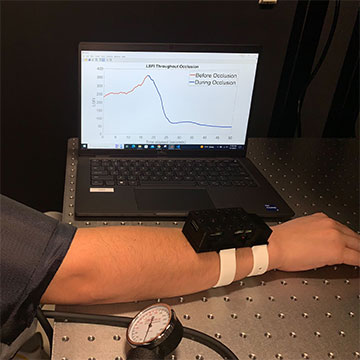
Researchers developed a wrist-worn device that uses laser speckle imaging to catch early signs of postpartum hemorrhage. [Image: Francesca Bonetta-Misteli, Washington University in St. Louis]
Postpartum hemorrhage can harm or kill new mothers in the hours or days after they give birth, but the bleeding is hard to detect until it becomes a full-blown medical emergency. A laser-based wearable device could give health care providers an early warning of maternal blood loss (Biomed. Opt. Express, doi: 10.1364/BOE.494720).
The prototype instrument, designed to be worn on a patient’s wrist, contains a 785-nm-wavelength laser diode and near-infrared camera. The light interacts with the blood flowing through the patient’s arm, and laser speckle imaging can reveal a drop in flow before the loss of blood volume reaches crisis proportions.
Blood loss and the body
After birth, the uterus is supposed to contract and compress the blood vessels that had connected the placenta to the womb. If that doesn’t happen, or if some other complication occurs, these arteries and veins can let blood flow out freely.
The hemorrhage isn’t apparent at first because, in a process called peripheral vasoconstriction, the body will keep blood flowing to the vital organs by restricting circulation to the limbs. Patients may not show symptoms on visual inspection until they faint or go into shock due to the volume of blood loss. Health care providers do not have tools that can detect vasoconstriction in limbs during the early stages of hidden bleeding.
Testing laser speckle imaging
Researchers at Washington University in St. Louis (WUSTL), USA, assembled the proof-of-concept device from a 50-mW laser diode with a spot size of 0.26 cm2 and a double-lens camera module with a CMOS sensor and no infrared filter. A small single-board computer controlled the laser diode and processed the collected video data.
In the first test of the instrument, the team 3D-printed mockups of blood vessels and routed a blood-like liquid through the channels. By changing the flow rates to simulate peripheral vasoconstriction, the researchers verified the device’s linear response to the changes.
The researchers hope to enroll pregnant women in a WUSTL study of the device and to work with investigators in countries with high mortality rates from postpartum bleeding.
Next, the group tested the laser speckle device on live pigs, which have many physiological similarities to humans. With the prototype device mounted on the animal’s “wrist,” or lower foreleg, the researchers inserted blood-draw and arterial blood-pressure equipment into two ports located in the pig’s groin. As the scientists drew out larger and larger volumes of blood and replaced them with saline solution intravenously, they found a strong correlation between the laser speckle flow index, as calculated by the device software, and the changes in the pig’s blood volume.
Preventing maternal mortality
Potential enhancements to the wrist-mounted prototype include improving the battery life and laser stability. The researchers hope to enroll pregnant women in a WUSTL study of the device and to work with investigators in countries with high mortality rates from postpartum bleeding.
“We were inspired to develop an accessible tool that can be used in both low- and high-resource settings to detect this condition earlier than current methods,” said research team leader Christine O’Brien. “This work is the first step in the development and proof-of-concept testing of our initial prototype.”
